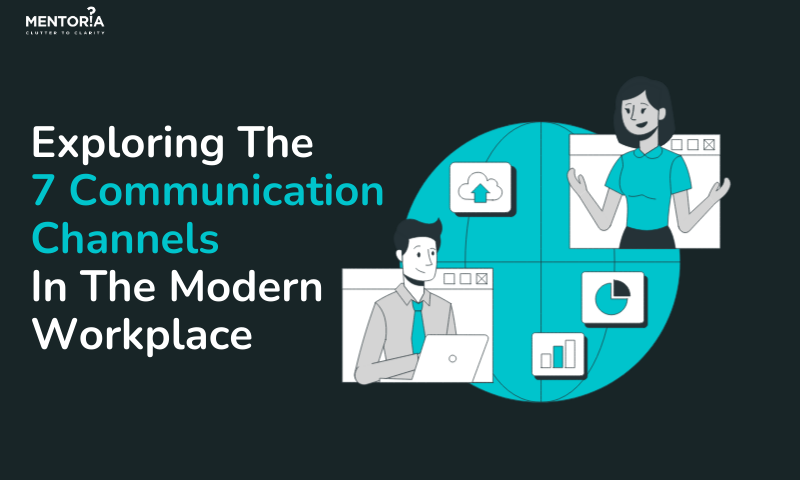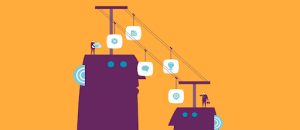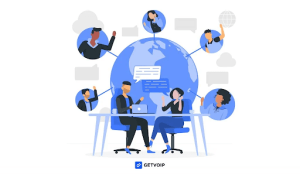Exploring The 7 Communication Channels In The Modern Workplace

Jump to Section
Hey there, fellow modern-day workers! Do you ever feel like you’re swimming in a sea of communication channels in the workplace? Emails, chat, video calls, carrier pigeons…okay, maybe not the last one. But with so many ways to communicate, it can be tough to know which one to use in different situations. That’s why we’re here to help! In this blog, we’ll explore the 7 most common communication channels in the modern workplace and give you tips on how to use them effectively. So grab a cup of coffee, sit back, and let’s dive in!
Face-to-Face: The OG Communication Channel
Ah, good old face-to-face communication. You know, that thing where you actually talk to someone in person? It may seem ancient in our world of Zoom and Google Meet, but it’s still the OG of communication channels.
Face-to-face communication is when you interact with someone in person, either in a one-on-one setting or in a group. It can happen in the office, at a coffee shop, or even on a park bench. Some examples include team meetings, interviews, and water cooler chats.
Now, let’s talk about the advantages. With face-to-face communication, you get to see the person’s body language and facial expressions, which can help you understand their message better. Plus, it can build trust and foster stronger relationships. But of course, there are also some disadvantages, such as the time and effort it takes to coordinate a face-to-face meeting, as well as the potential for distractions in the environment.
To make the most out of face-to-face communication, be present and engaged, listen actively, and maintain eye contact. And if you’re meeting in a public place, maybe avoid the park bench if it’s raining. Just a thought.
E-Mails: The Digital Pigeon Carriers of the Modern Workplace
In this digital age, e-mails have become the digital version of pigeons, delivering important messages across the vast expanse of the internet. Whether you’re working from home or from the office, e-mails remain a crucial communication channel in the modern workplace.
The biggest advantage is that they allow you to communicate with anyone, anywhere, anytime. Plus, you don’t have to worry about interrupting someone’s workflow with a phone call or an in-person visit. On the downside, emails can be easily misinterpreted, leading to misunderstandings and hurt feelings.
To avoid any mishaps, here are some tips for effective email communication:
- Be clear and concise – no one has time to read an essay in their inbox.
- Use a professional tone – avoid using slang or emojis.
- Double-check your spelling and grammar – nothing says “unprofessional” like a typo-ridden email.
- Use a clear subject line – this helps the recipient know what the email is about and prioritise their inbox.
- Use a professional email signature – include your name, job title, and contact information.
Follow these tips, and you’ll be hitting “send” with confidence in no time. Just remember, once you hit send, there’s no going back. So, make sure you proofread and double-check before you regret it later.
LOL to BRB: Navigating Instant Messaging Communication in the Workplace
In today’s fast-paced world, instant messaging has become a staple in the workplace. Whether it’s a quick check-in with a colleague or a team collaboration, instant messaging can be a powerful tool. But with great power comes great responsibility.
With platforms like Slack, Microsoft Teams, and WhatsApp, you can easily keep in touch with your team members without ever having to leave your desk (or bed, we don’t judge).
The advantages of instant messaging include its speed and convenience. You can quickly get in touch with someone without having to leave your desk or wait for a response to an email. However, the downside is that it can also be a distraction and disrupt productivity. It’s important to set boundaries and use them appropriately.
While it’s tempting to use slang or emojis, it’s important to remember that this is still a work communication tool. Keep your language and tone professional. Don’t bombard someone with messages, and avoid sending messages during non-work hours unless it’s an emergency.
Ring, Ring! Who’s There? Effective Phone Communication Tips!
Phone communication is a classic yet essential communication channel in the modern workplace.
Advantages of phone communication include the ability to convey emotions and tone of voice, which can help prevent misunderstandings. Disadvantages include the potential for miscommunication due to language barriers, poor reception, or background noise.
But fear not! Here are some tips for effective phone communication:
- Speak clearly and slowly, enunciating each word.
- Use a friendly and professional tone to establish rapport.
- Listen actively and ask clarifying questions to ensure understanding.
- Keep a notepad handy to jot down important information.
- Be aware of the background noise and avoid interrupting others.
By following these tips, you can ace your phone communication game and avoid awkward silences or misunderstandings.
Zooming Into Video Conferencing!
Get ready to put on your best shirt (and pyjamas on the bottom) because it’s time for video conferencing! Video conferencing is a communication method that allows people to see and hear each other in real time, no matter where they are in the world. Examples of video conferencing platforms include Zoom, Google Meet, and Skype.
The advantages of video conferencing include being able to have face-to-face interactions without having to be in the same room, which is especially useful for remote work or long-distance communication. The disadvantages include technical difficulties (ever had to ask “Can you hear me now?”), Internet connection problems, and the occasional awkward silence.
To make sure your video conferencing experience is smooth and effective, make sure to dress appropriately (at least from the waist up!), test your equipment beforehand, and be mindful of your surroundings (no messy bedrooms in the background, please!). And if all else fails, don’t be afraid to use those virtual backgrounds to hide the chaos.
Slide Into Their DMs: Navigating Social Media Communication In The Workplace
Social media is a powerful tool that has revolutionised the way we communicate and interact with each other. It’s no surprise that it has also found its way into the workplace, with platforms like LinkedIn and Twitter being used for professional networking and communication. However, social media can also be a minefield, with its own set of unspoken rules and pitfalls to avoid.
The advantages of social media communication in the workplace include its speed and convenience, the ability to connect with people across geographical boundaries, and the ease of sharing and accessing information. However, social media communication can also be informal and prone to misunderstandings, and there are concerns about privacy and security.
Make sure everyone in your workplace is aware of the do’s and don’ts of social media communication. Establish guidelines around what kind of information can be shared, who can access it, and how to handle sensitive information.
Making Collaboration Software Your BFF
Welcome to the future of teamwork! Collaboration software is the ultimate weapon for breaking down communication barriers and getting everyone on the same page. Think of it like a virtual brainstorming session where you can share ideas, assign tasks, and track progress in real-time. Examples of collaboration software include Asana, Trello, and Monday.com. So if you’re ready to level up your team’s communication game, grab your mouse and get ready to collaborate like never before!
Advantages? You can get stuff done from the comfort of your bed or while sipping a piña colada on a beach in Bali. Disadvantages? It’s like trying to herd cats – getting everyone on the same page can be a pain in the neck.
To effectively communicate through collaboration software, establish clear guidelines and protocols, like “no emojis in professional messages” (unless they’re the sunglasses emoji, of course). Use features like assigning tasks and sharing files to their full potential. And most importantly, keep your cool and maintain a positive attitude. No one wants to work with a Negative Nancy.
Speak The Language Of Workplace Communication
Remember, the key to effective workplace communication is choosing the right channel for the message. And with these tips, you’ll be speaking the language of workplace communication in no time. Now, go forth and communicate like a pro! If you are looking for guidance on how to navigate your career in today’s ever-changing workforce, Mentoria can help. As a career counselling firm, Mentoria provides personalised career guidance to help you achieve your professional goals. With their expert advice and guidance, you can take control of your career and find the flexibility you need to thrive in today’s world.










